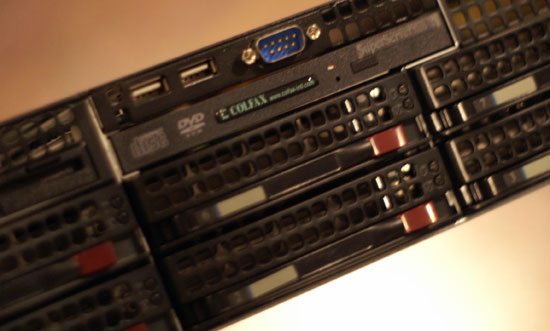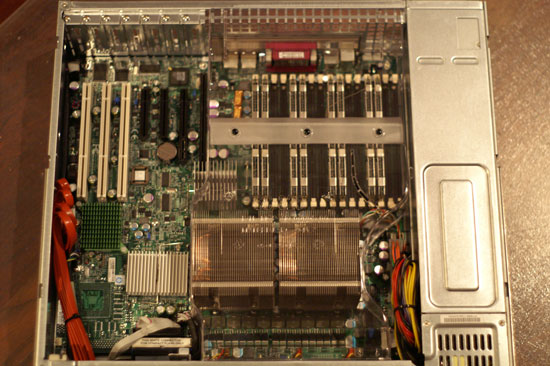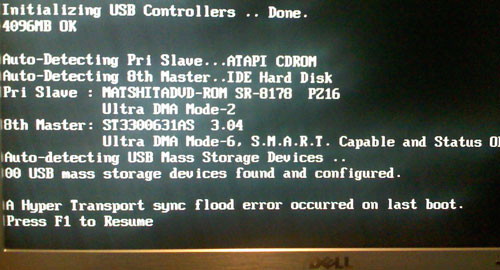AMD Phenom Preview: Barcelona Desktop Benchmarks
by Anand Lal Shimpi on September 10, 2007 12:03 AM EST- Posted in
- CPUs
The Servers
AMD was kind enough to send us two servers, identically configured, from Colfax. The configurations were as follows:
| AMD | Intel | |
| Motherboard | Supermicro H8DMU+ | Supermicro X7DBE+ |
| BIOS Revision | DMU8157v3.ROM | R1.3C |
| CPU | 2 x Opteron 2350 (2.0GHz) | 2 x Xeon 5345 (2.3GHz) |
| Memory | 8GB (8 x 1GB DDR2-667) | 8GB (8 x 1GB FBDIMM-667) |
| Hard Disk | 1 x Seagate Barracuda ES (400GB) | 1 x Seagate Barracuda ES (400GB) |
| Power Supply | 700W Redundant | 700W Redundant |
| OS | Windows Server 2003 SP1, 64-bit | Windows Server 2003 SP1, 64-bit |
These are standard Socket-1207 servers, meaning they don't take advantage of the split power-planes of Barcelona. Newer motherboards (such as the one Johan used in his tests) will support split power-planes, allowing Barcelona to run its North Bridge at a higher clock frequency, thus improving memory performance. Note that our desktop benchmarks were run under Windows Vista Ultimate (32-bit). Update: AMD has confirmed that these motherboards are Socket-1207+ and thus support split power-planes. We apologize for the error.

2U Colfax server

Colfax Intel Server

Colfax AMD Server, one CPU removed
Both systems worked just fine, but we did spend more time with the AMD system (obviously). During our testing we'd occasionally get a Hyper Transport error upon reboot, but it was intermittent and didn't interfere with our results:

Then, at the very end (literally two hours before publication) of our benchmarking, the AMD server stopped POSTing. As of now the system will simply sit there and spin its fans without actually putting anything on the screen. A number of things could have happened, but thankfully the Barcelona system decided to die after we ran all of our tests.
The take away point here is that AMD is working as quickly as possible to push out this Barcelona release. While AMD states to expect availability as early as today, we're concerned about the maturity of these platforms. We got our test systems on Friday, if this were truly a large, widespread launch we would've had hardware long ago. Whereas everyone and their mom already has a sample of Intel's 45nm CPUs, Barcelona continues to be tough to come by and performance hasn't been anywhere near final until now.
Logistics aside, we now have final silicon in hand (and a dead server on our floor), so let's see what we can do.










70 Comments
View All Comments
lopri - Monday, September 10, 2007 - link
Was thinking the exact same thing. Because the ~20% advantage in games just didn't make sense considering that the gaming benchmark is probably the most single-threaded in nature. If taken as its face value, the performance gain would be huge (which only would grow as the number of core increases).PlasmaBomb - Monday, September 10, 2007 - link
CPU-z says the voltage required to achieve 2.5GHz on a Barcelona was 1.52V, what was it set to in the BIOS?Spuke - Monday, September 10, 2007 - link
...it looks like AMD will be a great alternative to Intel. The present K8 is already competitive performance-wise with Conroe and the Barcelona core looks to be MUCH quicker than K8. If Penryn is only 5% faster than Conroe, then I foresee Phenom being equal to Penryn. Well, that is unless you believe single digit gains to be LARGE advantages.Hulk - Monday, September 10, 2007 - link
"The present K8 is already competitive performance-wise with Conroe..."Huh? Every review I've ever read comparing K8 with Conroe shows Conroe being significantly faster in 9 out of 10 tests at the same clockspeed.
Sunbird - Monday, September 10, 2007 - link
And the reviews with P4s and A64 were showing the A64 winning 9 out of 10 at same clockspeeds, the megahertz myth is busted. The only thing that really matters is price to performance and to some overclocking and maybe platform cost and heat...strikeback03 - Monday, September 10, 2007 - link
Except the post being replied to did not mention price, only performance. In the desktop market Intel currently beats AMD clock for clock and their top parts are clearly faster than AMD top parts. Depending on how much you get your processor for, AMD can be competitive on price per dollar, but on pure performance not so much right now.Spuke - Monday, September 10, 2007 - link
I said competitive with Intel not "hair on fire" faster than Intel. Two different things. At the framerates these CPU's are getting nowadays, the performance differences are irrelevant at least in gaming and near irrelevant in other benchmarks. Unless you're making money of these systems where every second counts, the differences are truly insignificant. And I won't get into the J6P market.strikeback03 - Tuesday, September 11, 2007 - link
Well, I don't game, so framerates in that sense are rather meaningless to me. On the other hand if I have a couple hundred photos to convert from RAW to TIFF, then open in CS2 and apply some other corrections, the time savings of running on a 3GHz quad-core C2D over a 3GHz AMD solution (1 or two processor) can be significant. I'd imagine those who do video rendering feel the same way.Regs - Monday, September 10, 2007 - link
It's really too early to tell. It's what we all expected. They should of been released at 2.6 and scaled up to 3.0+ Ghz. Not 1.8 to 2.5 Ghz.hirschma - Monday, September 10, 2007 - link
I'd love to know what happens when a Barcelona is inserted into an AMD 4x4 platform. Does it work?